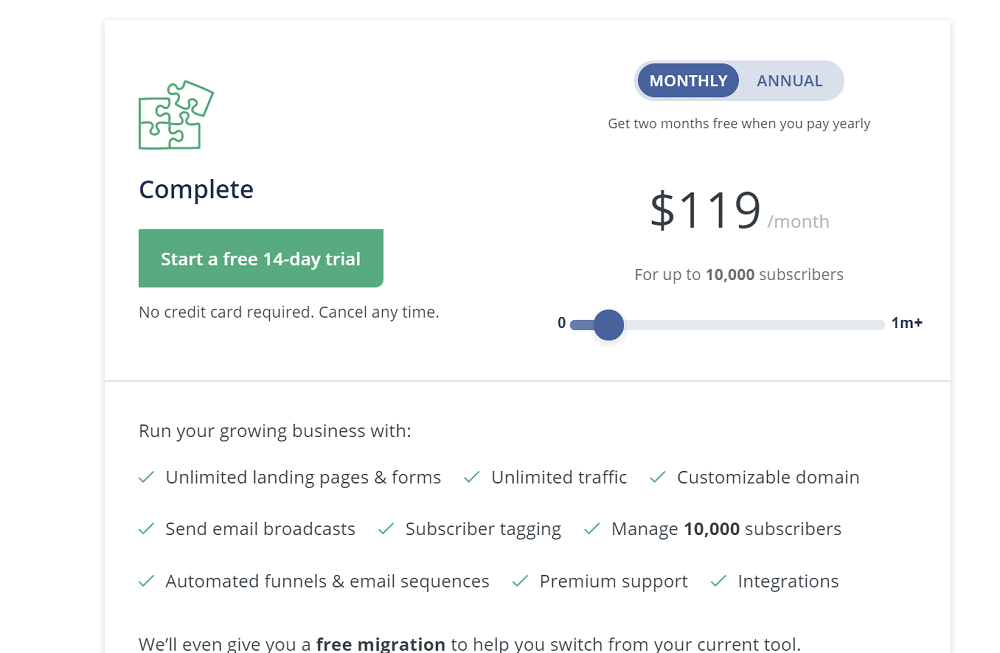These days, there are nearly endless ways to connect with your audience. You can build a robust web platform, launch engaging social campaigns, or even reach out via SMS.
Despite all the new technologies and trends of the last few years, one thing remains clear: email marketing is king. Each year it’s ROI continues to go up. For every dollar you invest in it, you can expect about $42 in return. Nowhere else out there offers that kind of return.
There’s so much to love about email marketing. You can finely segment your lists to directly target certain audiences, write as much or as little as you’d like, and really create the perfect sales funnel.
These days, there seems to be no shortage of email marketing providers. From MailerLite to Sendinblue, you can find absolute bargains to advanced services equipped to handle enterprise-level tasks.
ConvertKit is one of the more recent entries in this highly crowded field. It’s pretty highly rated and usually makes it into the top 10 rankings for email providers.
Aimed at creatives like bloggers and designers, in particular, you can use it to not only launch email campaigns, but also build landing pages, forms, workflows, and more. However, it is also a touch pricier than some of its competitors.
Is ConvertKit worth it? Should you switch from your current email marketing provider? Discover everything you need to know in this ultimate ConvertKit review.
What Is ConvertKit?
ConvertKit is a cloud-based lead generation hub designed particularly for creatives like bloggers, podcasters, YouTubers, and small businesses who frequently share content online.
With ConvertKit, you can employ a wide array of email marketing tools like automated email marketing, workflow automation as well as landing pages, and opt-in forms to grow your subscriber list and encourage engagement.
The interface is simple and easy-to-use, making it great for segmenting lists, posting updates, and as well adding lead magnets and additional integrations.
ConvertKit offers a free membership for up to 1000 subscribers. After this, plans start at $25/month billed annually.
ConvertKit Features
- Email marketing
- Form building
- Analytics
- Dynamic content
- Automations
- Landing pages
- Broadcasts
- Templates
- Drag-and-drop editor
- Drip campaigns
- Segmentation
Getting Started With ConvertKit
Since ConvertKit offers a free plan, you can get started using it just by entering your email address, creating an account password, and answering a few simple questions. That’s right, no credit card required!

From here, you’ll be taken to your dashboard, where you can get started creating a landing page or a campaign. There are also some helpful intro videos for the newbies out there.
But if you’ve ever used an email marketing client before or even a CMS like WordPress, this will all feel very familiar.
One really cool thing about ConvertKit, if you’re new to the world of email marketing is you can create custom landing pages, and ConvertKit will host them for you. This is a great way to save some cash if you don’t have the resources for your own web platform.
ConvertKit also has course modules you can check out to further help you drive ROI out of it. And if you design courses or webinars, it’s a good place to source a little inspiration.

ConvertKit Pricing
As mentioned, ConvertKit has a free plan, but this only covers up to 1,000 subscribers. The free plan includes these features:
- Unlimited landing pages & forms
- Unlimited traffic
- Customizable domain
- Send email broadcasts
- Subscriber tagging
- Manage 1,000 subscribers
This is a pretty sweet deal for newbies and matches up with the free plans offered by MailerLite, MailChimp, and others.
However, if you want to be able to migrate your subscribers for free or use integrations and funnels, you’ll have to opt for a $29/month plan. This also includes premium support and email sequences.
From here, pricing is based on the number of subscribers you have:
- 1,000: $29/mo
- 3,000: $49/mo
- 5,000: $79/mo
- 10,000: $119/mo
- 25,000: $199/mo
- 50,000: $379/mo
ConvertKit is definitely on the pricier side. Here’s a look at MailerLite’s price breakdown in comparison:
- 1,000 contacts: $0/mo
- 2,500: $15/mo
- 5,000: $30/mo
- 10,000: $50/mo
- 15,000: $75/mo
It’s even more expensive than industry-leading MailChimp. Take a look:
- 2,000 contacts: $0/mo
- 2,500: $29.99/mo
- 10,000: $75.99/mo
- 30,000: $219/mo
- 50,000: $259/mo
Is ConvertKit worth the extra price? Take a look at some of the features below and see what you think.

ConvertKit Features
ConvertKit has a wide array of different features. Here are some of the main things you’ll do with it:
1) Email Editor
If you’re looking for fancy-looking emails with all the bells and whistles, then you’ve come to the wrong place. ConvertKit is built-around a different mindset. Based on their studies, they’ve found that similar emails actually perform better than more complex ones. There’s actually something to this as well.
Aside from performance and usability issues that can arise from complex, media-heavy emails, they also feel less personal to users and can have lower click-through rates.
For these reasons, ConvertKit’s email editor, Broadcasts, is pretty basic. You get a small selection of tested email and newsletter templates with basic editing options like background and color. That’s about it.

2) Subscriber Management
No email marketing tool would be complete with subscriber management. This is a great ConvertKit feature that lets you tag subscribers to help you organize them in a ton of different ways. This is different from MailChimp, which is focused on the number of lists you have instead.
You can create a tag for literally everything. Likewise, while adding new subscribers, you can put them on specific lists, add certain autoresponders, segment them, and more. From here, you’ll be able to track key analytic like total subscribers, average open rate, and click rate.

3) Forms & Landing Pages
This is one of the best ConvertKit features and, ultimately, what you’ll use to decide whether it’s the right option for you.
And ConvertKit doesn’t disappoint here. The tool is excellent and well-packaged inside a great user interface. You get a nice selection of templates, editing options, and then essential advanced features like:
- Selecting actions for when customers engage with a form
- Automatically send emails to new subscribers
- Changing what’s show to returning visitors
- Different results for search and social
You’ll also get stats that show you visitors, subscribers, and conversion rates to help you design accordingly. And if you don’t have your own site, you can use these features through a ConvertKit hosted landing page.
Other email services have similar offerings, but few wrap it up in such an excellent package.

4) Automations
ConvertKit has nailed the autoresponder. It makes it easy to set up automations, add & tag new subscribers, select conditions and events, and so on.
If you’re new to automations or need a little inspiration, they also have cool automation templates like for hosting webinars, launching new products, and newsletters. Do note you have to be on a paid plan to use automations.

5) Integrations
ConvertKit currently has nearly 100 direct integrations plus hundreds more through Zapier. This gives it a ton of flexibility. For example, you can link a Shopify page and create new automations like sending promotions to those who sign up for the mailing list as well as track exact interests and purchases. The same excellent functionality goes for CRM, payment, Facebook ads, and so many other web apps.

Who Should Use ConvertKit?
ConvertKit is targeted towards bloggers, creatives, as well as email marketers with eCommerce platforms. Despite the generous free plan and a variety of onboarding tools, this software is definitely for experienced marketers.
From building landing pages to A/B testing and advanced segmenting, you can hyper-focus onto the target audience and specific members to create extremely detailed campaigns.
As you might imagine, the skills to this might be beyond newer marketers and SME owners just looking to grow their subscriber lists.
ConvertKit is very clear with this and even has a page detailing the types of people who’d be better off sticking with MailChimp.
If you manage multiple lists, don’t sell products, or want beautiful email templates, then ConvertKit isn’t for you. But if you want to invest and grow your blog and audience, then this could be the right tool for you.
Is ConvertKit Worth It?
That’s a tough question. There are a lot of other email marketing services that have overlapping features. ConvertKit will be the first one out there to tell you they don’t offer the most affordable service.
But it’s not like ConvertKit is full of enterprise-grade hyper-advanced features. They’re a little more in the middle. One of the main advantages it does have over something like ConvertKit is how well-focused it is.
You don’t have to navigate a ton of additional menu options and windows. And the analytics directly tell you what parts of your campaigns are working and what aren’t.
The software itself also performs really well and quickly.
If lead generation and engagement outside your lists are just as important as what’s going on inside your emails, then ConvertKit is worth it. But if not, you may better off going with a more affordable alternative.
Pros
- Excellent conversion tools
- Set up automation easily
- A large number of integrations
- Good support
- Great UI
- Tag-based instead of list-based
- Can host landing pages if you need
- Built-in analytics for landing pages
- Easy to auto-resend broadcast
Cons
- A little pricier
- The email editor is a little basic (that’s deliberate thought)
- More email templates would be helpful
- A mobile app would be nice
ConvertKit Alternatives
Email marketing solutions are a dime a dozen. You can go advanced like Klaviyo or find great budget options like MailerLite. In some ways, this is why ConvertKit stands in its own category because it’s focused specifically on experienced marketers without getting needlessly complex.
Still, if you’re on a budget, you should definitely check out MailerLite. If you want to add in SMS campaigns and some other great features, and still get a good deal, then try out Sendinblue.
What Is MailerLite?
MailerLite is one of our consistent recommendations as an all-around excellent email marketing tool. In addition to boasting of a huge range of features that match anything AWeber or MailChimp can throw at you, it also has form building and generation tools, is super easy to use, and very affordable.
MailerLite doesn’t have quite as many direct integrations, and the landing pages aren’t as fancy as ConvertKit, but at less than half the cost, it’s definitely a better option for those on a budget.
What Is Sendinblue?
Sendinblue is another more affordable option, but it also has a few tricks up its sleeve. It not only includes email tools but also offers SMS marketing and CRM features that allow you to put your entire custom interaction under one easy-to-use dashboard.
Sendinblue also has a different pricing model based on the number of emails you send rather than contacts. You be the judge of which is better, but it does give you a little more flexibility and doesn’t make you feel forced to delete subscribers to stay under the cap between plans.
The Lite Plan for $25/month gets you 40,000 emails/month going up to Premium plan starting at $66/month for 120,000 emails.
ConvertKit, Sendinblue, and MailerLite all offer free plans, so check them out yourself and see which one you like best.
ConvertKit: The Verdict
If you’re looking for a slightly more advanced and lead-generation focused email marketing solution, ConvertKit is a solid option. But it is a little expensive, so do your homework and check out the other options to help you decide if it’s the right addition to your marketing tool belt.
ConverKit Review
-
Features
-
Pricing
-
Ease of Use
-
Support
-
Overall
Summary
ConvertKit is a cloud-based lead generation hub. It is targeted towards bloggers and creatives, as well as email marketers with eCommerce platforms. ConvertKit has a wide array of different features like email marketing, form building, analytics, dynamic content, automation, and more. ConvertKit is a slightly more advanced and lead-generation focused email marketing solution. Read this review of ConvertKit to learn more now.
















